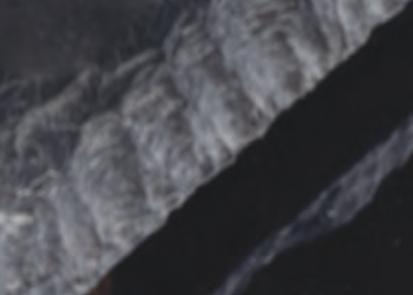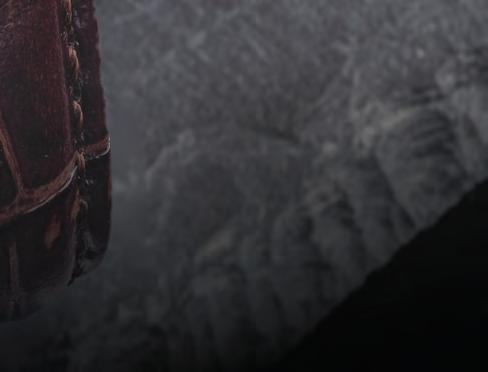
























Ever see a commercial harbor full of Furuno Marine Electronics and wonder why the pros rely on us?





See why here









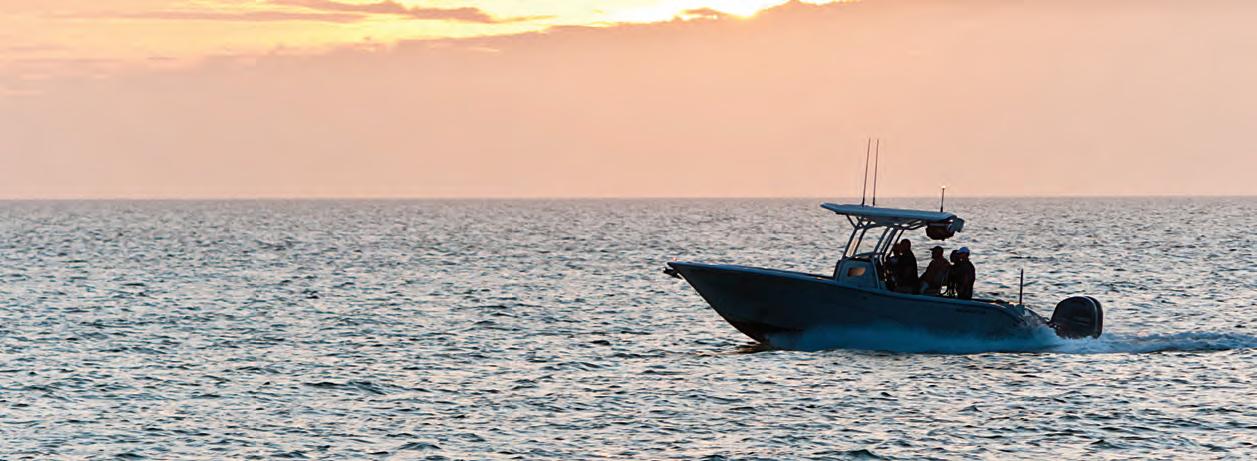
Are you ready to embark on your next on-water adventure? Before you set sail, here are fve things to know about boat insurance.
1. Boat insurance isn’t just for accidents
With comprehensive coverage, you’ll also be protected fnancially for theft, vandalism, and unexpected events like storms if you need repairs or replacements due to damage.
2. Accidents can happen to anyone
When accidents happen, boat insurance offers liability coverage for damages or injuries you cause while boating, up to specifed limits. It can also cover lawsuit costs if you’re sued.
3. Boat insurance can cover medical payments
Boat insurance offers a range of optional medical payments coverage limits, helping to cover medical expenses if you’re in an accident or someone is hurt on your boat, regardless of fault.
4. Most lenders require boat insurance
If you fnanced your boat, you’ll likely need boat insurance since most lenders require boat insurance to protect their investment. Additionally, some marinas or municipalities require proof of insurance for docking.
5. Progressive offers specialized boat coverages
Ever worry about getting stuck on the water?
Progressive’s Sign & Glide® On-Water Towing coverage** can help. It’s an additional coverage that steps in if your boat is disabled or breaks down on the water, paying for on-water towing, jump starts, soft ungroundings, and fuel delivery. Fuel cost isn’t included.
Don’t let unforeseen circumstances disrupt your voyage. Cruise with confdence thanks to Progressive Boat insurance. Because when it comes to your boat, peace of mind is the ultimate luxury.
Scan to get a quote in as little as 4 minutes.
to learn more.




















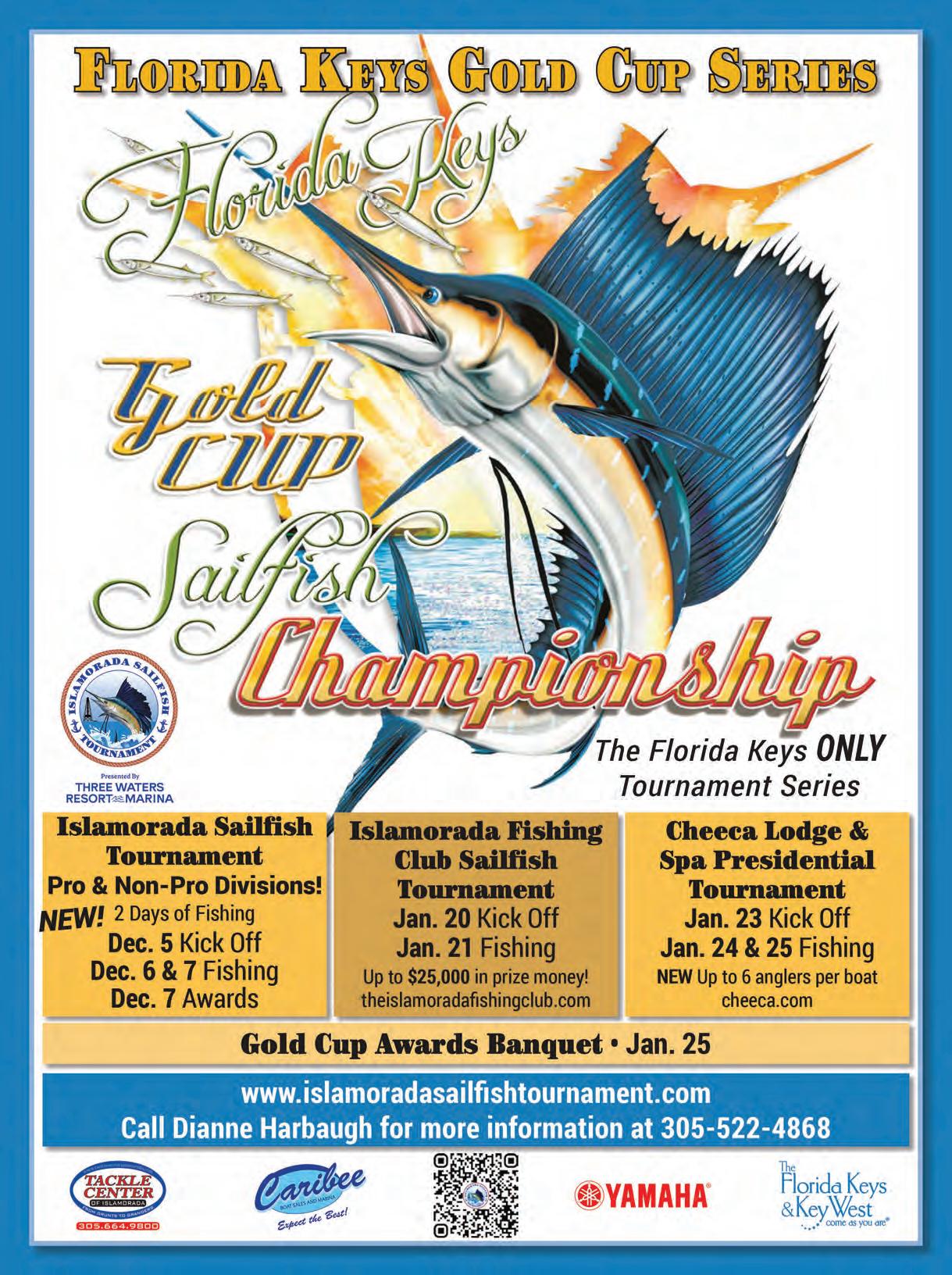


There’s remote, and then there’s Pulley Ridge. Sitting over 100 miles o! the coast of Florida, this underwater plateau is where the Gulf of Mexico drops into the deep blue, and it’s earned a legendary reputation as one of the most productive, and challenging, shing destinations in the U.S.


By Astrid deGruchy


If you’re heading out there, you’ll need a serious o!shore machine. ink a 47’ Freeman or a Viking, something that can handle the long run and unpredictable Gulf conditions. is isn’t a trip for small center consoles or light tackle. Last time we were out there, we loaded up with PENN Fathom electrics paired with PENN Ally Electric rods & PENN International 50 VISX ready to drop into depths that test both your gear and your patience.
Using chicken rigs, we hauled in vermillion and yellow snappers in over 500 . of water that lled the box, but Pulley Ridge has a wild side where giant groupers and the occasional “what-the-heck-is-that” monsters lurk in the dark.


Pulley Ridge isn’t just another shing trip, it’s a rite of passage. e distance, the depth, the unknown, it all adds up to one of those bucket-list adventures every angler should do once in their life, especially with a crew of buddies who live for the chase. While you’re out there, you can even make a stop at the Dry Tortugas, another incredible o!shore destination rich in history and beauty.
Check out the full Pulley Ridge expedition on YouTube, only on Bean Sport shing TV.







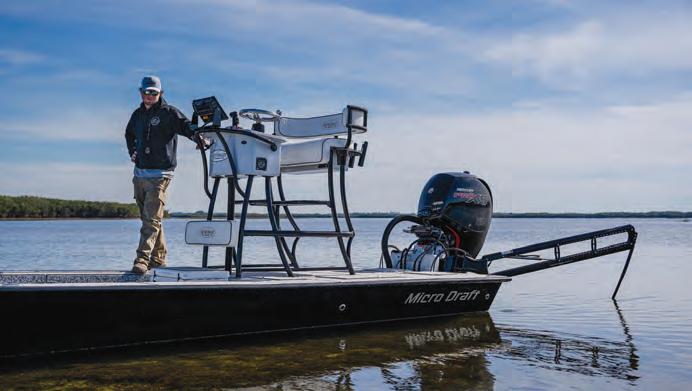





By Julie Graham

The Cherokee National Forest o!ers some of the best freestone trout shing in the Southeast. Spanning 650,000 acres across the Southern Appalachians, it’s the largest block of public land in Tennessee and it’s divided neatly in two by the Great Smoky Mountains National Park.
On the north side, mountain streams tumble through hemlock hollows toward Cosby. To the south, the waters of Citico Creek cut deep through wilderness ridges near the Unicoi Mountains. Together, they showcase the Cherokee’s range. From roadside creeks to backcountry runs, the forest o!ers anglers a taste of freestone Tennessee trout water.
Below the Great Smoky Mountains National Park boundary, Cosby Creek winds through the community of Cosby, Tennessee, o!ering accessible trout
water without the added park permit. ese lower stretches are regularly stocked by the Tennessee Wildlife Resources Agency (TWRA) and can provide productive shing throughout spring and fall. While access is somewhat limited, anglers will nd several bridges and pull-o!s along Highway 32 where they can wade in. e streambed is rocky and slick, with plenty of boulder pockets and undercut banks—good traction and careful footing are essential. Expect stocked rainbows with the occasional brown trout.
Inside the Park, the Cosby Campground section is ideal for bank shing and light wading, especially for those who prefer easy access close to trails and picnic areas. Brook trout dominate the upper reaches, while rainbows hold in the deeper pools below.
To the south, Citico Creek drains more than 20,000 acres of rugged country on the western edge of the Cherokee. Fed by the north and south forks rising in the Unicoi Mountains, Citico o!ers a blend of stocked and wild trout water—ideal for anglers who like a mix of easy access and adventure.
e TWRA regularly stocks Citico from Little Citico Creek to the Citico Creek Wilderness boundary, while the upper forks hold self-sustaining populations of wild rainbows and browns.
e Cherohala Skyway marks the southern edge of the Citico Creek watershed, and just driving it is worth the trip—sweeping vistas, ery fall colors, and the sound of water around every bend.
Autumn is prime time on both sides of the Cherokee National Forest. Water temperatures drop, trout feed hard before winter, and the hardwood ridges turn to ame.
• Match the Hatch: Early fall favors terrestrials; in November, go small with blue-winged olives, midges, and caddis emergers.
• Go Light: Clear, low ows call for 6X or 7X tippet and longer casts.
• Mind the Leaves: Dri leaves can snag a line—look for deeper pools below ri&es where trout hold under cover.
• Start Late: Cooler nights mean shing o en improves mid-morning as the water warms slightly.
For more information, including licensing regulations, visit the Tennessee Wildlife Resources Agency at https://www.tn.gov/twra.html.


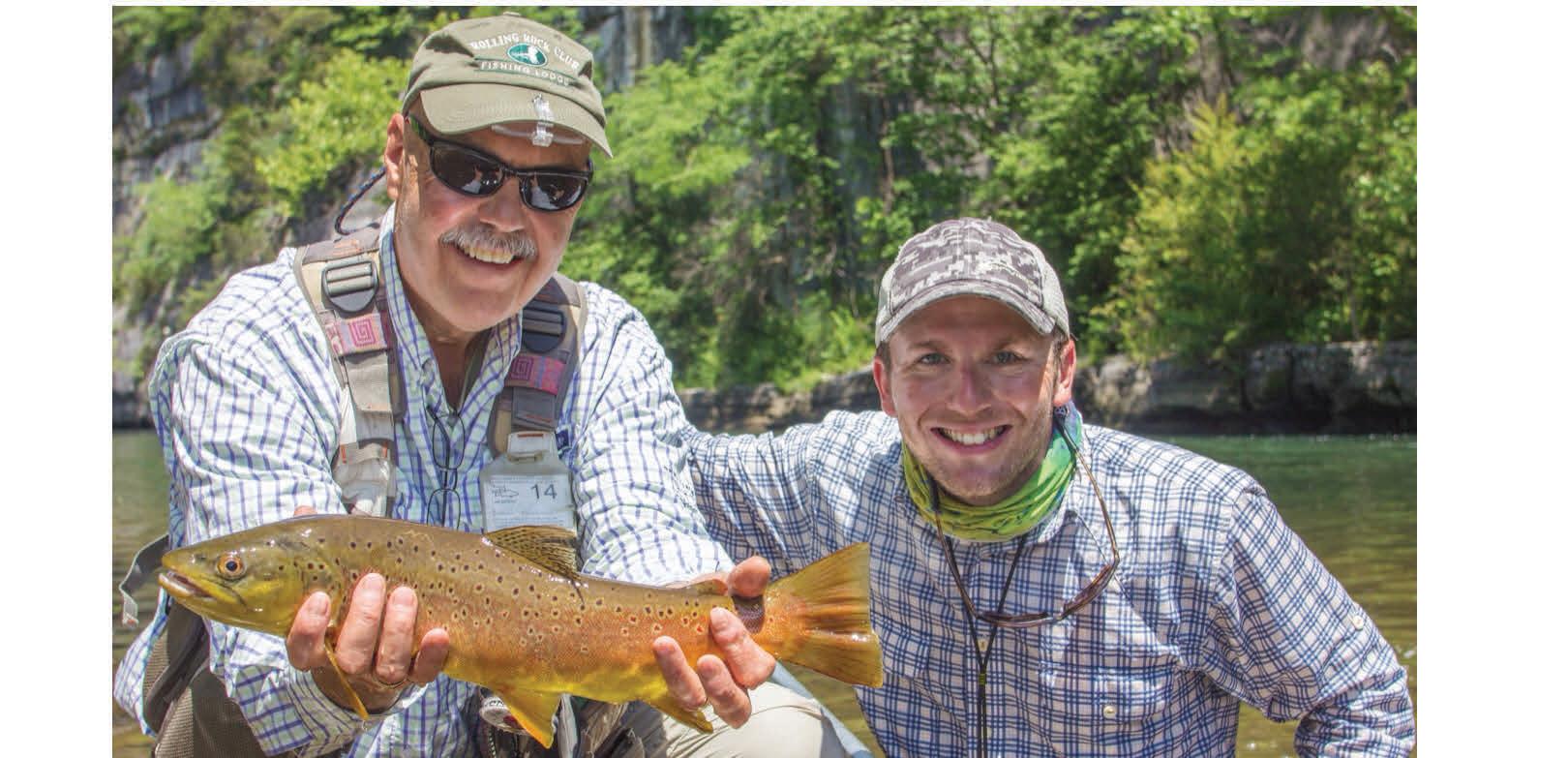








































































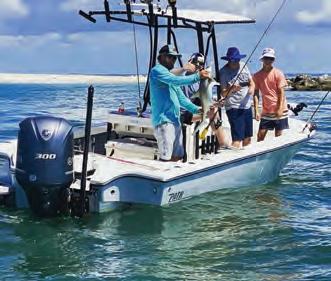



















By Capt. Michael Okruhlik
There’s just something magical about fall shing. e air cools, the bait thins out, and everything that swims gets a little hungrier. For me, it’s the holy trinity of the season— ounder migrations, trout and reds chasing shrimp under screaming gulls, and the early whispers of trophy trout time.
The Fall Flounder Run
Ah, yes, the famous fall ounder migration. is is more prevalent in some areas, but they can be caught all along the Gulf Coast. ese at ambushers stack up near the passes as they make their way to spawn in the
Gulf, gorging on bait along the way. When I’m targeting ounder, I switch things up. My go-to is a scented so plastic, preferably the Titan Series from Knockin Tail Lures. Not only are they scented, but they also have a rattling tail. Working this along the bottom will entice violent strikes. Since ounder love to bury themselves and wait in ambush, I keep that lure tapping bottom, twitching my rod sideways, whether I’m wading or boating. It’s a nesse game—part patience, part persistence—and when that telltale “thump” hits, it’s pure satisfaction.
Birds, Bait, and Mayhem
en there’s the chaos of gulls dive-bombing over shrimp and schooling sh—a sight that’ll make any angler’s pulse jump. Fall o en brings bigger trout into the mix, turning every cast into a thrill. I prefer to use a heavier jighead (1/4 to 3/8 ounce) to achieve the desired action without spooking the birds or the sh. Durable so plastics help keep me in the ght longer, and I mash the barbs down for quick releases and faster re-casts. When the schools settle and the birds thin out, a topwater lure can coax the bruisers to rise— and few things beat watching a big trout explode on the surface.
As fall rolls on, my focus shi s toward trophy trout—and timing becomes everything. I’ve followed solunar shing tables since childhood, back when my grandparents’ calendars marked “good” and “poor” shing days with little sh icons. Over the years, I’ve been both a believer and a skeptic, but I’ve noticed a pattern: my best bites o en align with solunar peaks. Now, I plan my day around them. Instead of running and gunning, I’ll anchor in a promising area during a predicted feeding window and wait it out.
On a recent trip with my boys, we missed the morning bite but stuck it out for the next solunar cycle. We anchored near a grass edge meeting a sandy at and, right on cue, rods bent. For seventy glorious minutes red sh hit every few casts, and sometimes we doubled up. My sons were smiling, the drag was screaming, and the solunar chart earned another believer that day.
So as the air cools and the sh feed up, grab a rod, bring a kid, and let the tides—and maybe the moon—guide your next adventure.
Capt. Michael Okruhlik is the inventor of Knockin Tail Lures,® and the owner of www.MyCoastOutdoors.com.




Mastry Engine Center has received the Suzuki Marine Super Service Award and has been ranked #1 in Suzuki Marine US Sales! 60 YEARS OF REPOWER EXPERIENCE!

RePower Packages designed to best ft your needs and not stretch your budget.
Financing available.

Rest assured, all Mastry Suzuki RePowers are backed by Suzuki’s industry leading 5-year factory warranty.

Stationed strategically around the East Coast, all Suzuki RePower Centers have achieved the highest level of Suzuki certifcations to meet and exceed your repower needs.
When Considering A Repower, Consider These Factors:
•Every Authorized Mastry Suzuki RePower Center has decades of repower experience providing proper rigging, controls, propeller matching and in water testing
•With a Mastry Suzuki RePower, owners gain improved performance, less noise and greater reliability
•Mastry Suzuki RePower’s exclusive Owner’s Edge Program*
•Mastry Suzuki RePower Centers use authentic Suzuki OEM parts and have factory certifed technicians

Since 2014, Mastry Engine Center, has been building the premiere Suzuki Outboard repower network in Florida. Today, Authorized Mastry Suzuki Outboard Centers have been exceeding expectaions in the Southeast for over two decades. Recently Suzuki Marine requested Mastry Engine Center to expand the network throughout the Northeast. Now boat owners from Maine to Florida can be assured of the best support for their Suzuki outboard repower project. All Authorized Mastry Suzuki RePower Centers provide the best options, information and package pricing for excellent performance in repower.




When you purchase a new Suzuki outboard from an authorized Mastry RePower Center you qualify to become a member of the Mastry Suzuki Owner’s Edge. Owners receive an identifcation card that provides them with important information about their Suzuki outboard motor as well as a passport to additional benefts during ownership. Members enjoy a detailed engine maintenance schedule, Mastry Suzuki RePower Trade Program and special pricing from Mastry Suzuki Partners *Get with the Program!


In the world of watersports and outdoor lifestyle, staying connected to what’s next isn’t optional—it’s essential. For 50 years, Surf Expo has been where the industry comes together to discover new products, make connections, and set the tone for the season ahead.
Returning to the Orange County Convention Center in Orlando, January 7–9, 2026, Surf Expo celebrates its 50th anniversary with an event that honors ve decades of driving the business of the waterman lifestyle forward. e show draws thousands of quali ed retail buyers, brands, and industry professionals from across the U.S. and around the world.
Surf Expo has long been the industry’s launchpad for what’s next. It’s where new brands make their debut and where trusted names unveil their latest collections. On the show oor, sustainability, functionality, and style continue to drive the next wave of coastal and outdoor retail—trends that shape what ends up in your store and, ultimately, in the hands of your customers.
Re ecting the growing connection between coastal and outdoor lifestyles, Surf Expo’s Shoreline Outdoor area continues to expand— bringing together products designed for life on the water and adventures on land. is growing segment highlights essentials for outdoor adventure, from versatile apparel and gear to innovative accessories that move seamlessly from coast to camp.
Shoreline Outdoor features brands and products that bridge categories—boating, shing, paddling, hiking, and camping—meeting consumer demand for versatility and performance. Retailers will nd quality, functional, and sustainable products built for modern outdoor enthusiasts. ink waterproof bags, insulated coolers, portable re pits, backpacks, multifunctional jackets, and drinkware designed for any setting. is lifestyle focused area captures the spirit of adventure—friends gathered by a re pit a er a day on the water, paddleboards pulled up on the sand, or cozy campsites under starlit skies. It’s all about embracing the outdoors in every way.
What makes Surf Expo such an essential stop on the retail calendar? It’s the unmatched variety. Hardgoods, apparel and accessories that bridge the gap between beachwear and everyday wear, Surf Expo delivers products that de ne coastal and outdoor living. Whether your customers are anglers, surfers, paddleboarders, kayakers or simply love the water or the outdoors, you’ll nd fresh lines and innovations that resonate.
Surf Expo remains much more than aisles of product—it’s a place to learn, connect and recharge your business strategy. Educational sessions, in-booth demos and networking events o er valuable insights into consumer behavior, merchandising and market trends.
Join them January 7–9, 2026 as they celebrate 50 years of Surf Expo— and experience rsthand why this show continues to be the heartbeat of the coastal and outdoor lifestyle industry.
Quali ed retail buyers register for free before 12/24 at surfexpo.com




By November, redfish have passed the peak of their spawning season in Tampa Bay, but the increase in fishing activity hasn’t. Large schools of redfish can still be found on most grass flats throughout the area. Achieving success when targeting redfish involves a few key strategies.
If you are fishing along a mangrove shoreline, it is crucial to fish close to the mangroves. Redfish prefer to feed just inside the mangroves, around low-hanging branches and roots. Chumming with live bait is effective for drawing them out from the bushes and increasing your chances of a catch.
Always be vigilant for schools of mullet when pursuing redfish, as redfish often travel within these schools. When mullet are approaching, position your boat so that they pass downwind and within casting distance. Begin chumming heavily with live bait. If redfish are mixed in with the mullet, you'll notice explosive strikes on the bait you toss out. Prolonged chumming will attract more fish to your boat.
Learning to tell the difference between mullet and redfish schools is vital. Mullet tend to push water more aggressively and frequently break the surface, often jumping out of the water.
Continued on page 6











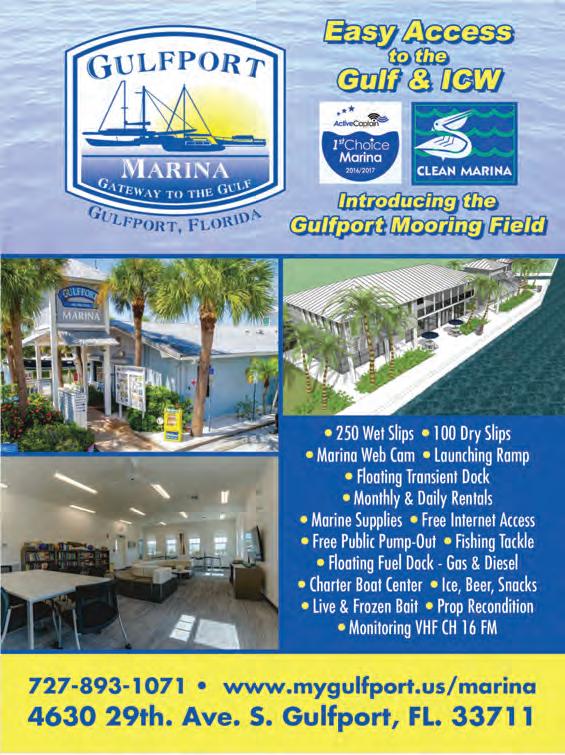
By: Capt. George Hastick

If you haven’t heard about Dropout Cast Nets in the Tampa Bay area yet, I would be surprised. They have hit the market with a storm, with many of the Bay area fishing guides adding them to their arsenal. They are the best bang for the buck in cast nets. They are using higher quality mesh netting that has been treated to be very soft and supple in your hands and ready to use right out of the bucket. The high quality of the mesh and the treatments they do to it gives you a net that is comfortable to handle and opens easily to get the most bait per throw. This net was developed by Captains and fishermen for fishermen. This is the reason why Captains and guides are making the switch to Dropout Cast Nets. Their 10’ 1/4” & 3/8” nets (most popular nets) are $195 - $205 compared to some of the higher priced nets reaching upwards of $330, which can become costly if you get a hole in it or get it stuck on the bottom. This brings me to their limited lifetime warranty of 50% off MSRP, if you should wreck your net, to get a new one. You really can’t go wrong with Dropout Cast Nets. Check out their variety of different nets from 3’-12’ at https://www. dropoutcastnets.com or check your local Tampa Bay area tackle shop. I’ve made the switch and enjoy using their nets.
BY: CAPT. ANTHONY CORCELLA


Soon, the first cold front will hit our area and the water temps will drop to the magical 74-degree mark. As November approaches, so does the west coast flounder run. These odd flat fish with both eyes on top is one of the best eating fish in our waters. One of the best things about them is that they are predictable and easy to target. That doesn't mean they are easy to catch!
Inshore flounder will move into any sandy bottom area surrounded by grass or structure. Shallow pot holes on grass flats, the edges of channels, or sandy areas around oyster beds will all hold fish. Flounder will attack lures and live bait as it runs across their area. The trick is to slow down the presentation as flounder are ambush predator’s that lay in wait for food to swim by.
When you feel the thump, give a slight pause before setting the hook. Flounder tend to grab a bait or lure and will hold it in their teeth lined mouth before swallowing the offering. That's the part that makes them tricky to catch. When you feel the thump, lower the rod tip and then strike. They should be hooked up. If you miss, slightly move the bait or lure and the flounder might attack again. They are ferocious predators.
Best baits are live shrimp, mud minnows (aka killifish), or whitebait. Lures such as soft plastics on a 1/6 to1/4-ounce jighead, or suspended lures like a Mirror-Lure, work great. A trout sized set up works fine for these fish. A 7-foot 6-inch fast-action rod with a 2500 to 3000 class reel loaded with 10-pound braid is all you need. 15 to 20-pound fluorocarbon leader is perfect. If fishing live bait, 1/0 to 3/0 hooks matched to bait size will work best. Circle hooks work well, because the fish will hook themselves if they pull on the bait.
A big flounder can feel like a snag--a snag that wants to swim away with your bait! They will grab the bait or lure and try to bury back into the sand.
Flounder will stack up in rocky off shore bottom in 20 to 40 feet. Some really nice sized fish can be caught. If you run into the bigger flounder, bump your tackle up to 12 to 17-pound spinning gear. Live or dead shrimp on a jighead or knocker rig will always produce. A bonus of hog snapper is also a possibility.

The flounder bite will remain hot until the water really cools down around mid-to-late December. If you find one flounder, keep fishing the area. These guys like to school up. Multiple fish can come from the same spot. They are best eaten fresh, so never keep more than what you will need for a few dinners. Contact us to book a trip and for more info. Now it's time to take these tips and get out there and fish!
— What makes our charter service unique is that we cater to disabled veterans and wheel chair bound clients! Our boat is able to accommodate wheelchairs and is ADA compliant. IF YOU’RE A DISABLED VETERAN, YOUR TRIP IS FREE! This is our way of giving back to our veterans.
Capt. Anthony Corcella, Pocket Change Inshore Fishing Charter 727-432-6446 www.pocketchangefishingcharters.com Check us out on Facebook, Instagram and TikTok



WBy Capt. Wes Tallyn
inter months are a great time to look for a small songbird called a prairie warbler in the Tampa Bay Area! A smaller number of them are here year-round, but many migrating prairie warblers will also join in and winter in Florida.
The prairie warbler is an approximately five inches long songbird that is identified by its bright yellow coloration with dark, fine streaks around the eye and along its sides. These birds consistently bob their tails up and down. This characteristic helps with a quick observation. I often refer to them as “mangrove warblers,” because I often hear them calling in the mangroves when I’m fishing the islands throughout Tampa Bay.
The prairie warblers are found in the summer along most of the eastern seaboard, through the Appalachian Mountains, and through most of the Deep South. They will winter along the Florida coast and in many of the Caribbean islands. They feed, almost exclusively, on insects, so try planting fire bush or other heavy flowering plants to attract them to your yard.



Negative tides predominantly occur during the winter months, typically around the new and full moons, resulting in exceptionally low water levels—these are often indicated as minus tides on tide charts. Such tides represent instances when the low tide is significantly lower than usual. On Florida’s Gulf Coast, a combination of strong northerly winds and high-pressure systems following a cold front can further drive water away from the shore, exacerbating these effects. During lower, clearer winter tides, hidden features like cuts, oyster bars, rocky bottoms and deep-water grass flats are revealed.
Negative tides concentrate fish in certain areas such as depressions and cuts on the flats, deep mangrove cuts and old concrete blocks and debris used by the homeowner as their own mini reef under their boat dock. There are a few reasons why the fish concentrate here. For one, they don't have anywhere else to go! Often, the flats where these fish hold most of the year will be dried up, only to be enjoyed by the wading birds. I've caught snook and redfish out of a depression on a flat that was almost completely dry.
When fishing negative tides, identifying the target species for the day determines where to fish. Trout can be found around potholes on flats, while redfish or snook may be located near docks. Exposed rock piles, seawalls and rocky shorelines absorb heat as the sun rises, increasing water temperatures by up to 3 degrees. This temperature change can be beneficial for species such as sheepshead, redfish and trout, particularly on colder days.
When fishing the flats, arrive at least an hour before the negative tide and position your boat within casting distance of the hole or, if fishing a cut, make sure you are set up to be able to move from the shallowest to deepest part of the cut as the tide drops allowing you to cover more area.

Baits are dependent on the species, location and whether you are using live bait or artificial bait. Shrimp for me is best used when fishing around docks and deep drops around edges of channels. Here is where I find the redfish, sheepshead and flounder most of the time. I lean towards artificials when fishing shallow waters potholes or edges of creeks for trout, the most common species in winter months.
Floats are another great tool for Trout fishing in the winter, especially the weighted type such as the 4-Horsemen, an excellent float for windy days, and the noise they produce drives trout crazy. Here is a trick I have been doing for over 30 years during the winter months, attach a 2/0 J hook to the swivel at the bottom of the float. Trout seem to hit the float as a top water plug, thus hooking two at a time.
Saltwater Assassin on a jig head. The weight depends on depth of water, wind conditions and whether you are fishing on edges of the drop or over grass beds. My go to weight is 1/8-ounce cuts along the edges of the flats and ¼-ounce when fishing deep potholes like some of the bomb holes around Ft. DeSoto Park.
Fishin’ Assassin with flashing mylar tape adds a little flare and might
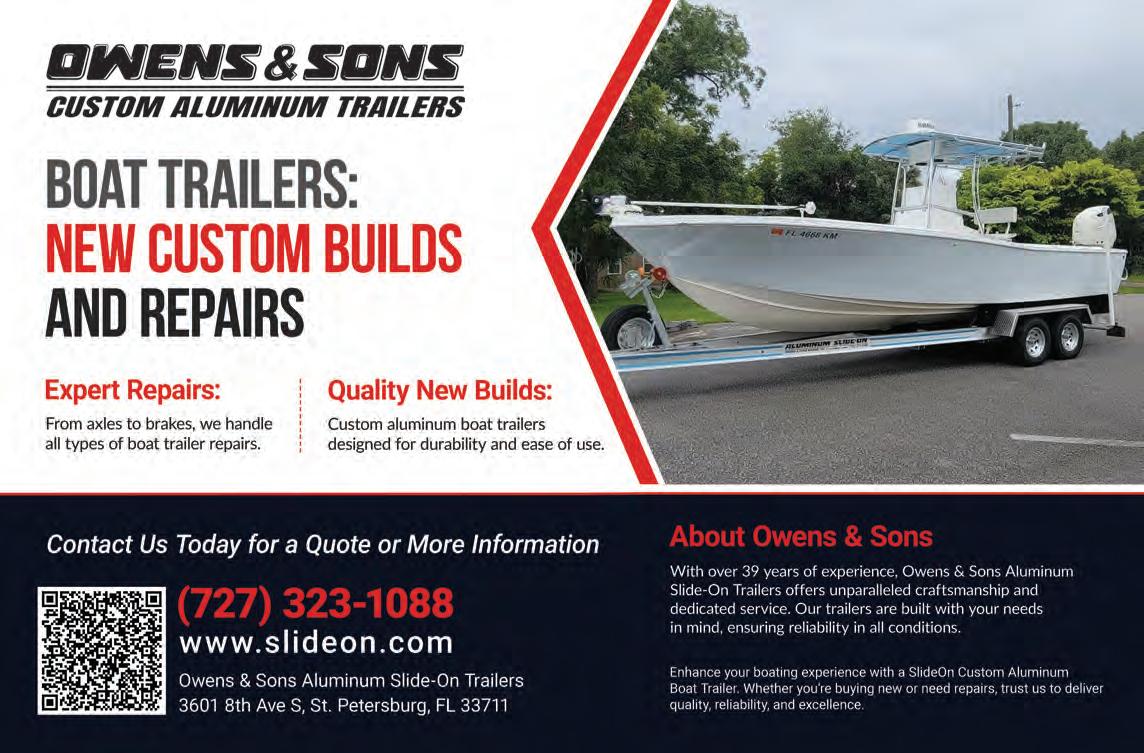

sound like a gimmick. It does work on a consistent basis over regular jig heads in clear water.


NED Jigs, used in conjunction with small soft baits, are a killer when fishing the shallow mangroves during a falling tide that offers a quiet presentation that mimics small bait fish or shrimp.
Recommended Rods, Reels, Line and Leaders: Dependent on whether you’re using live bait or artificial bait, here is my breakdown on my favorites.
Rods (Blackfin): Live bait 7 ft medium action 8–20-pound class. Artificial bait 7.6 ft medium action fast taper in 8–17-pound class.
Reels: 3000 for live bait, 2500 for artificial bait use.
Line braided (FINS): Live bait 15-pound test. Artificial bait 10-pound test.
Fluorocarbon Leader (Lee Fisher Sports): Length of leader starting at 36 inches. Live bait 25-pound test. Artificial bait 15-pound test.
Knots: Line to leader Surgeon’s knot. Leader to hook improved Clinch knot.
— Capt. Sergio Atanes is host of Florida West Coast Fishing Report on Facebook and YouTube. He also hosts Fishing Adventures Florida TV show airing on YouTube, Waypoint TV, Carbon TV, Outdoor Action, and Angling TV. Owner of Reelfishy.com Charter business covering the west coast of Florida with over 135 captains on staff. For information contact Capt. Sergio at (813) 973-7132 email: atanes@msn.com.





In contrast, redfish schools, especially during high tide, create wakes that are less noticeable. Look for subtle differences in the ripples on the water's surface to identify a redfish school.
As water temperatures begin to drop, the snook activity increases too. With the spawn completed, large female snook are now focused on feeding rather than breeding. In the right spot during good tidal flow, it is possible to catch ten or more snook within an hour. Chumming with live bait helps to stimulate feeding activity.
Prime snook spots include mangrove points adjacent to deep water, areas where mangroves are near oyster beds, and mangrove-lined creek or river mouths. These habitats provide excellent opportunities for snook fishing.

The seatrout bite continues to be strong throughout Tampa Bay. The most productive areas for large, keeper-sized seatrout are grass flats in four to six feet of water, although they can be found in many locations. Outgoing tides have recently yielded higher numbers and larger fish.
When fishing for seatrout, suspending bait under a float helps prevent it from getting tangled in the grass. Casting the bait at a ninety-degree angle off the side of the boat allows the tide to carry it naturally across the grass


flat. Once a seatrout takes the float under, close the bail by hand, reel in until the line is tight, and set the hook with a firm lift of the rod.
As we move towards the middle of November, stronger cold fronts start to pass through the area, causing water temperatures to drop. Over time, the change in water temperature prompts baitfish to leave the grass flats for deeper water and the game fish follow.
Last fall, baitfish remained on the flats until the third week in November and the fishing was excellent. I can only hope that we get a repeat this year. Until the bait moves out, continue to enjoy the excellent fishing opportunities that Tampa Bay provides during the fall. Afishionado, “Adventures in Fishing.”
—Tampa Bay fishing guide Wade Osborne of “Afishionado Guide Services” has been plying the waters of Tampa Bay as a professional full-time captain, since 1997. Capt. Osborne offers inshore fishing charters on light tackle spin, fly or plug. He also offers eco-tours with an emphasis on photography. For more info., visit Afishionado.com or find Afishionado Guide Services on Facebook and Instagram. Email: wade@afishionado.com Call/Text 813-286-3474






When winter cold fronts clean up the Gulf and push clear water inside, Tampa Bay’s near-shore hard bottom turns into prime ground for hook-and-cook hogfish. These shell-crunchers roam sand patches around limestone ledges, rock piles, and old pipeline humps in 15 to 40 feet. Think stealth, scent, and a bait that stays pinned to the bottom.
Tackle is light and precise. I fish 2500 to 3000 size Okuma spinning reels with 10 to 15-pound braid on a 7’ to 7’6” medium-light rod. Add a 3 to 4-foot section of 20 to 25-pound fluorocarbon leader. For hooks, go small and sharp--#1 to 1/0 inline circles (reef-legal) or a short-shank J, if you’re fishing jigs. Keep drag smooth. Hogfish hit like a pecking chicken, then bulldog once hooked.
Two rigs do nearly all the work. The first is a “knocker rig”. Slide a ¼ to 1-ounce egg sinker onto the leader, so it rests against the hook. It keeps a live or fresh shrimp anchored where hogs feed, nose in the sand. The second is a hog-ball style jig (1/4 to ¾-ounce) in pink or orange with a short leader to a #1 to 1/0 hook. Both present low and subtle, exactly what finicky hogs want.
Bait is simple. Live shrimp, fresh-dead shrimp, or small fiddler crabs. Pin the shrimp lightly through the last joint of the tail or the horn, so it stays lively. Trim the tail for extra scent. I’ll crush a few shrimp and toss them overboard to make a slow chum, nothing heavy, just enough smell to keep them looking down.
Boat position matters more than most anglers realize. Use side-scan to find swiss-cheese bottom, then anchor or Spot-Lock up-current, so your baits settle onto the target. Keep the boat quiet. Drop the rig straight down, thumb the spool to feel bottom, then do as little as possible. Hogfish are
BY: CAPT. JOSHUA TAYLOR
nibblers, don’t rip. When the taps turn into steady pressure, lift smoothly and reel. If you miss one, hold the bait still. The same fish often returns.
Timing matters, too. I target high-pressure days behind a front, with two feet of visibility and a halfknot drift. Mid-morning through early afternoon is consistent, especially on a gentle incoming tide. Work small spots thoroughly. If you haven’t had a bite in fifteen minutes, shift 50 to 100 yards and reset.


Here are a few housekeeping notes. Review current Gulf reef-fish rules before you go, use non-stainless inline circle hooks where required, and carry a dehooker. Ice your catch immediately for that sweet, clean fillet hogfish are famous for. Keep the program quiet, keep the bait on bottom, and you’ll put fillets in the box all winter long.
- Tight Lines
— Capt. Joshua Taylor is a professional angler, apparel designer, and influencer whose passion for fishing and dedication to storytelling meet. With years of experience on the water and behind the pen, Joshua ensures each issue is packed with expert tips, local reports, and stories that resonate with the angling community. Connect with Capt. Joshua Taylor: joshua@saltyscales.com www.saltyscales.com | Follow on Facebook: facebook.com/SaltyScales YouTube: youtube.com/saltyscales | Instagram: instagram.com/saltyscales TikTok: https://www.tiktok.com/@saltyscales
!


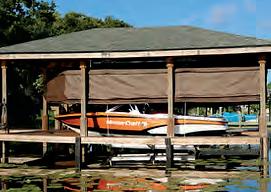


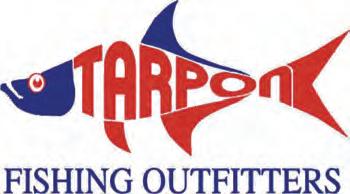









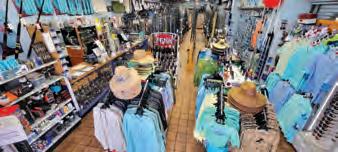















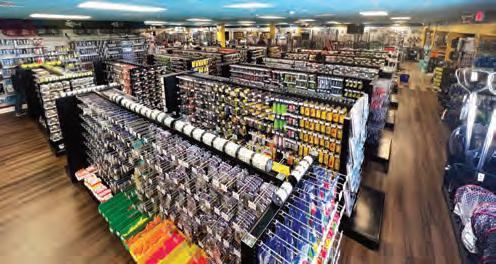










By: Bruce Butler
Having grown up in rural Indiana and being of Cherokee and Irish descent, many superstitions were drilled into me since my earliest days.
Despite being older and more sophisticated (more or less), I still find that I won't walk under a ladder. I knock on wood to ward off bad luck and face a black cat crossing my path with certain trepidation and of course I believe the banana curse wholeheartedly.
The first incident was while filming my very first TV show with my friend Glen Pla "The Average Angler". We had a horrible day, and as I said goodbye I saw a banana peel on his front seat; undoubtedly the culprit. After the removal of the “yellow peril” for future episodes we experienced great success together.
That was the first of my experiences with the "Yellow Peril" and fishing. The latest was on my last charter with Jim from Colorado. I told him I wouldn't use his name, but I lied. I only change names to protect the innocent!
I admit to a partial blame when I tell people what to bring. I always mention a hat, sunglasses water, sunscreen, etc. and jokingly (but in deadly earnest) not to bring a banana along.
We put in at Indian Bay in Aripeka and paddled North. I put him on spot after spot using both bait and lures - nothing! Now I'm not saying that the bite was hot, but I caught nice mangrove snapper, redfish and trout, but he could not catch a cold, I was dumbfounded!
Finally, at the lower end of the tide sitting inside of Indian key with bait



and mullet schools everywhere within a quarter-mile radius, he reached into his backpack and pulled it out!
I cross myself and screamed what's that!? “Oh my dad gave me this as I was leaving; I didn't think they can affect kayaks!”
Yes, the cardinal sin. He knew of the curse, and sealed his fate. But it gets worse.
“Let me get rid of it”, he said as he ate it and threw the peel to the tides and said, “there it's gone!”
We both turned our heads back to the Bay (which was alive with fish not five minutes ago) and there was nothing. Every fish within a half-mile radius was gone.
I'm not saying the banana was the cause, maybe thousands of fish just decided to leave at the same time by coincidence.
I doubt Jim will ever bring a banana with him ever again! Regardless, he still had a great time on the water.

So humming that old Monkee’s tune “I'm a Believer” as I sign off, may you have tight lines and no bananas!
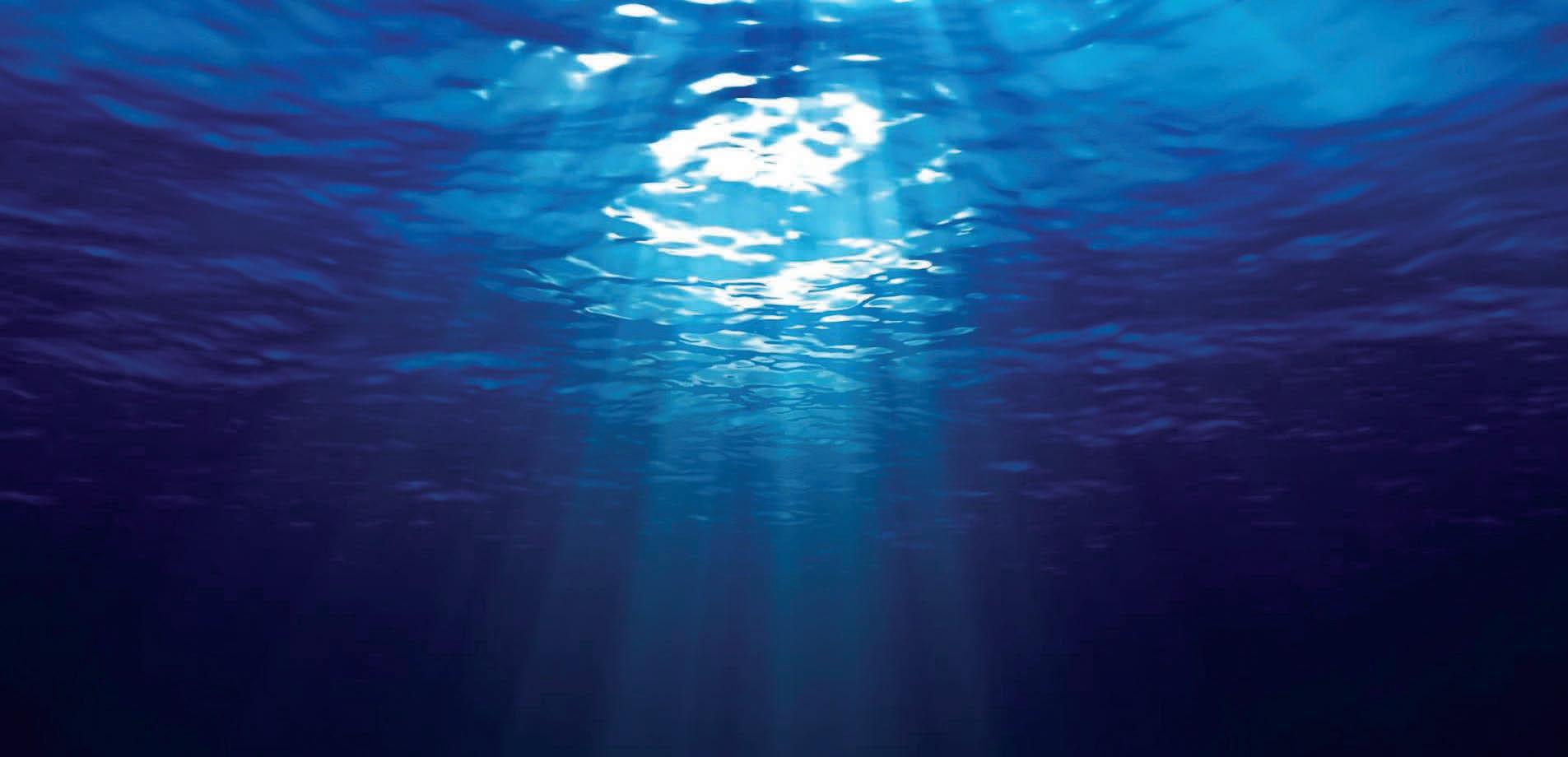











2
4
6
9
10





































9
8
5
6
4
1
2




















18
19
12:43P 2.5 11:29 2.9 6:23 -0.3 6:08 1.3 6:55 5:37
20 Thu 1:19P 2.4 11:57 3.0 6:56 -0.4 6:41 1.3 6:55 5:37
21 Fri 1:54 2.4 7:28 -0.4 7:13 1.3 6:56 5:37
22
23
24
25 Tue 2:13 2.8 4:18 2.2 9:47 -0.2 9:43 1.3 6:59 5:36
26 Wed 3:01 2.7 5:00 2.2 10:30 0.0 10:37 1.3 7:00 5:36
27
28
29














There are many ways to serve this delicious delicacy, but the one I use is a favorite among those who eat them cold and freshly cracked. Let me say, I purchase mine not cracked until we are ready to eat them. I also do not purchase them frozen, because the meat will stick to the shell. This can be a messy meal or treat. But, to me and my family, it is well worth the mess. We put down newspaper and get the roll of paper towel to put on the table. So, I will give you the recipe that we use with the crabs and many other foods.
Stone crab / Seafood sauce ingredients:
• 1 tbsp. plus ½ tsp. of dried Coleman’s mustard powder. If this is not available, any mustard powder will do.
• 1 cup of good mayonnaise
• 2 tsp. of Worcestershire sauce




































• 2 tbsp. of heavy cream (this can also be optional if you want a thinner sauce). Milk if not using cream, use 4 tbsp.
• Pinch of salt
Large bowl for mixing. You can do this by hand or use a blender. If you like the mustard powder and the tangy flavor, you can add a pinch more - - just taste before doing so. Enjoy!

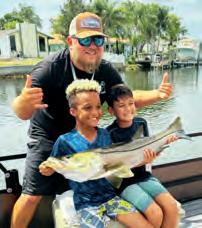

WBy Tobin Strickland

less than half a football field from my parked truck.
Here’s the deal: Fish don’t know they aren’t supposed to be somewhere. As long as the location matches what they are looking for, the fish will be there regardless of what the above-surface features look like.
So what makes a good fishing spot for speckled trout, redfish or flounder?
e all have an idea of what a good fishing spot should look like. Perhaps it’s surrounded by pristine sand dunes and native grasses and has that perfect seagrass bottom? Or maybe it’s a hidden marsh lagoon surrounded by mangroves? We spend so much time running to the prettiest spot and wonder why we don’t catch fish. Maybe it’s time to take a look at the ugly fishing spots.
I’ve found great fishing wherever great fishing occurs, and many times those locales haven’t been pretty. Earlier today, I ran the boat to several isolated bays only to find a school of nice speckled trout right behind the boat ramp. I knew the structure was right, and when I saw good sign of fish presence, I didn’t hesitate to fish close to the ramp. It was less than 50 yards to the entrance to the harbor. In fact, three other fishing boats left the harbor while I steadily caught fish.
We always feel the need to make the run to that “perfect” spot. I did that recently and made a 22-mile run. Granted, I knew fish were there—and I
First of all, it must be in the right part of the bay system for season. No spot will produce if it’s not where the bait and fish want to be seasonally. Next, it has to have the right structure for the fish you are targeting. If you’re seeking trout, that spot better be trout habitat. It should be the right depth for trout and give them plenty of opportunities to ambush prey from below, whether it’s a main-bay drop-off, the edge of an oyster reef or the edge of a pocket in the grass. The habitat must be a match for the species you are going after...period. And similarly to the seasonal requirement, the location has to have forage.
If a fishing spot contains all the above parameters, yet it’s a little less than pristine, that can be a great spot. Take, for example, a big-trout spot I found last fall. I found this location using aerial photography, and it seemed promising. There was deep water nearby, a great oyster reef and a mud bottom. It was in the upper section of the estuary, so I knew it would fit the bill for late fall and early winter. I did wonder how the boat traffic would be…because it was in the back of the harbor. I caught fish closer to my truck than the actual run distance to the spot was.
My recent location was similar. Did it matter to me that it wasn’t 22 miles away? Not after that first hookset; No.







BY: CAPT. BILL RUTHERFORD




As the fall fishing grows nearer and the water temperatures drop lower and lower, the bite in my region tends to take a dramatic turn. And, then it doesn’t. And, then it does. This is the time of year for cold fronts that can change things up in a matter of 24 hours. Water temps can fluctuate by up to 15 degrees within a week and 10 within a day or two during November, and the fish respond accordingly.


The inshore snook and cobia bite is fantastic when the water hangs out in the low 80’s, and the redfish will still be scouring the flats and eating cut bait. If we get a front and the water temp drops into the low 70’s or even high 60’s, expect those bites to turn off. Fear not though, lower water temps call for big trout to move closer to shore and into the backcountry, allowing most any angler a chance at catching a monster Gulf Coast yellow mouth, even from land. Additionally, sheepshead, black drum, and redfish will stack up in deeper holes and residential canals and love to eat shrimp or fiddler crabs that are readily available at most bait and tackle stores. For those of you with larger boats who can’t get skinny enough for the backcountry, fishing around 20 feet of water will land you some of the largest sheepshead our area has to offer. You can go to public reefs that will be holding plenty of fish and work around from there.
It is crucial this time of year to make sure you have an idea of the water temps before your trips, or be flexible once you launch and fish accordingly. The more you know before you go, the better off you will be!
— Captain Bill is a Florida native who grew up fishing the Gulf Coast. Being a proud Army Vet himself, he founded a charity called VetCatch that takes disabled veterans on cost free fishing trips in the Tampa Bay area. He guides out of New Port Richey fishing a 24-foot Shoalwater tower boat as well as the custom 25-foot VetCatch pontoon if needed for elderly/disabled fisherman. www.rustybucket.fish.










Adriel’s first snook! He caught it on a live mojarra in Terra Ceia Bay.

Torrea Cross caught this nice 24-inch red grouper (her personal best) on a live threadfin in about 125 feet of water. She said it gave her quite a fight!

Elisha Jones personal best redfish while kayak fishing in St Pete.

While setting the anchor to fish an oyster bar off the point of a dock, Cory Park saw the distinctive long bottom ray on the dorsal fin of a tarpon as it was breaching the surface. He hooked a dead pinfish through the lips and retrieved just under the surface while simulating a distressed baitfish. On the second cast, the 37-inch silver king nailed it!


Nacaida Kearns was wrapping up the day when this snook made its debut...
For your chance to get featured on the Brag Board, upload your high-quality photos (at least 1MB) with all of the catch details at: www.coastalanglermag.com





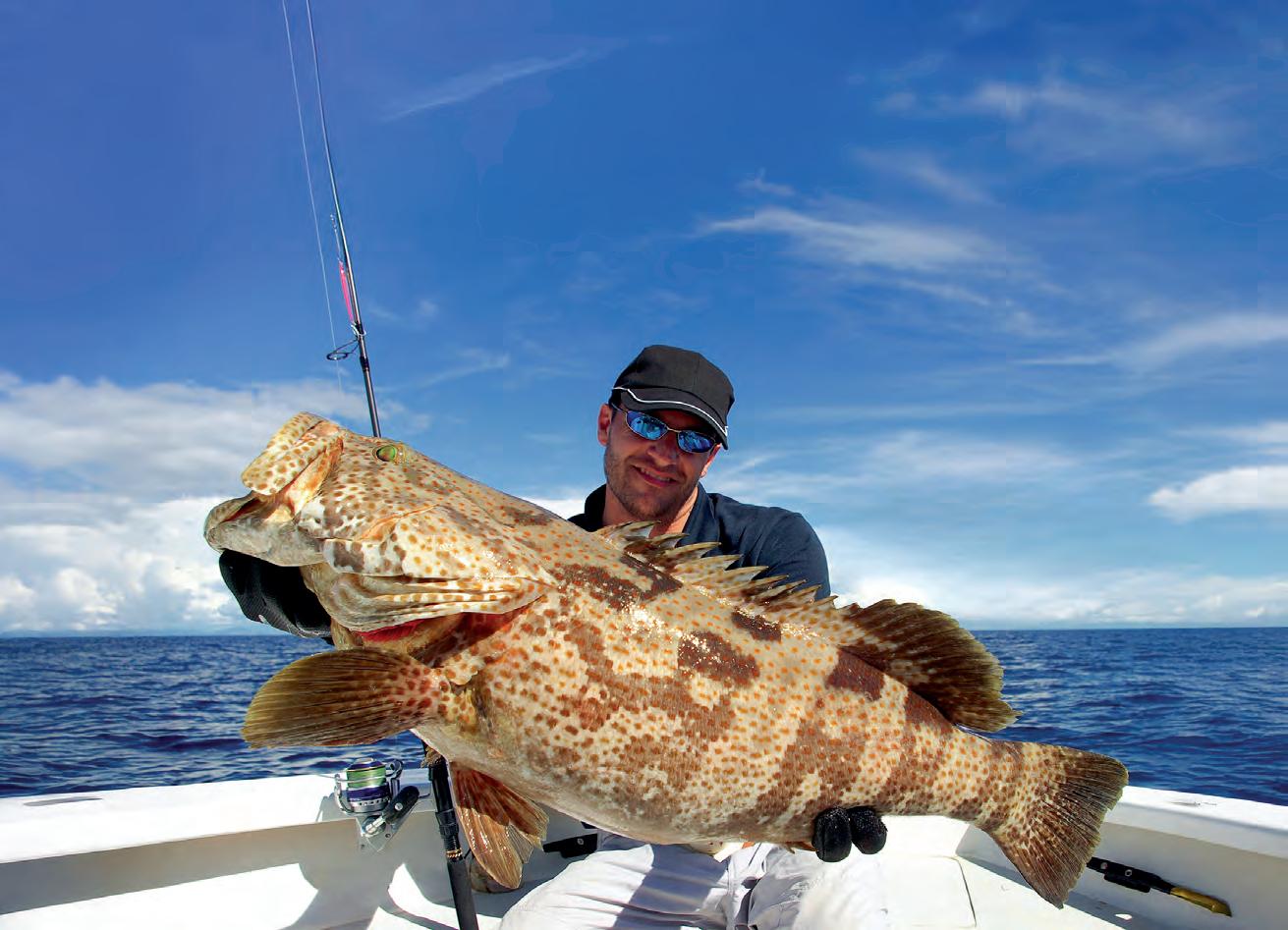






$14.99
Bring in your fresh, same-day catch and let us do the rest. We'll cook up to 2 lbs. of your filleted fish (bone-in okay) and serve it alongside two delicious sides of your choosing. We’ll accept just about any fish, except ladyfish, sea catfish, or bait fish.

ENDS NOVEMBER 30TH
We reserve the right to refuse any catch that appears unfit for preparation. Consumption of any outside food is at your own risk. The restaurant is not responsible for illness related to the handling, storage, or preparation of guest-provided fish.


GUIDE TRIPS AND CHARTER GIVEAWAYS! Where Fishing Meets Fellowship: Don’t Miss it!
Salt Strong Fishing Club Chapters are teaming up with ALL FLORIDA to bring anglers, families, and outdoor enthusiasts together for a one-of-a-kind day celebrating fishing, fellowship, and conservation.
Shriners Center, Tampa, Florida
INTERESTED IN SPONSORING THIS EVENT?
EMAIL DShuman@ShumanFoundation.ORG










Skill Building, Hands-On Learning Sessions and Conservation Education
How to Toss a Cast Net
Wade Fishing Techniques
Beach and Surf Fishing Techniques
How to Find YOUR Own Secret Fishing Spot
Bridge Fishing Techniques
KIDS Fishing Workshop
Hanging Oyster Garden Workshop And Much More!
Only 2,500 tickets left!
Winner Announced at the MEET-UP
BUY ONE TICKET, GET ONE FREE
WIN your dream boat, valued at over $90,000 MSRP At 22’ in length with a 97” beam, the Micro Draft Skiff 22 Extreme is built for versatility!

BROUGHT TO YOU BY


Salt Strong is more than a fishing club; it is a movement to unite, inspire, and empower anglers nationally. Salt Strong Chapters are located from Texas to Florida to the Carolinas and offer the opportunity to Meet Local Anglers, Learn from Informative Speakers, Participate in Conservation Activities, and Win Awesome Giveaways. Go to SaltStrong.com to stay up to date and to learn more.
By:
Darlene Shuman,
PE, President of Salt Strong Alliance
When I first reported on the SHARKED Act of 2025 back in March, it had just cleared the U.S. House of Representatives with strong bipartisan support. Seven months later, the bill has made impressive headway through the federal legislative process and is now one step away from becoming law.

This amberjack was shark-chomped during the Ladies Let’s Go Fishing Screamin’ Reels event in Islamorada, Florida last year aboard the SeaHorse with Captain Rick Rodriguez, (www.floridakeysfishing-charters.com)
Salt Strong Alliance endorses the SHARKED Act as part of its new Fins4Adoption Initiative, which aims to restore balance in marine ecosystems by raising and releasing juvenile fish of all types . As shark depredation increases, Salt Strong Alliance sees the SHARKED Act as a timely and science-driven effort to both protect our fisheries and uphold ethical stewardship of apex predators.
Veteran fishing guides are already adapting their techniques in response to rising depredation, Salt Strong Fishing Coach Captain “Hollywood” Mark Johnson, has witnessed the changes firsthand:
“There are days I have to leave a honey hole full of fish because the sharks show up and start picking them off one by one. I’m using heavier tackle and releasing fish quicker just to give them a chance. This isn’t just about

Let’s Go Fishing!”
Founded by Betty Bauman over 25 years ago, “Ladies, Let’s Go Fishing!®” has introduced more than 8,000 women to the joys of sportfishing through fun, hands-on weekend seminars.
Nicknamed the “No-Yelling School of Fishing,” LLGF events cover inshore and offshore fishing techniques with guidance from professional captains and instructors. From grappling grapefruits to mastering rod techniques, the program offers women a comfortable, non-intimidating space to build skills and confidence on the water.
Ladies, Let’s Go Fishing!® seminars have empowered women from all walks of life to discover a lifelong passion for conservation and fishing. Events are held across Florida.
Learn more or sign up at www.ladiesletsgofishing.com
losing fish—it’s about losing balance in the ecosystem. The SHARKED Act is a step in the right direction to understand what’s really going on out there.”
The SHARKED Act (“Supporting the Helping Anglers Respond to Knowledge of Ecological Depredation”) was introduced to address growing concerns about shark depredation — when sharks consume hooked fish before they can be landed. This frustrating and increasingly common occurrence is affecting recreational anglers and charter captains across the country, particularly in the Gulf of Mexico and Atlantic seaboard.
The Act seeks to establish a coordinated federal response to depredation by creating a task force under NOAA to research solutions, promote public education, and develop non-lethal deterrent technologies.
The final and most critical step is a full vote on the Senate floor at the Federal level. If the bill passes, it will head to the President’s desk to be signed into law. Once enacted:
• A task force will be formed under the Department of Commerce.
• The group will include scientists, fishery managers, angler representatives, and conservationists.
• Their goal: deliver practical, science-based solutions and outreach programs to reduce depredation events.



Only 2500 tickets left — your odds have never been better! The future of Florida fishing starts with clean water — and you can help protect it with just one raffle ticket! Want to win the ultimate shallow-water skiff AND protect our Coastal Corridors?
Here’s your chance — and now it’s BOGO: Buy One Ticket, Get One FREE — double your chances to win, double your impact.
This isn’t just about winning a dream boat (valued at over $90,000 MSRP) — it’s about taking action.
As anglers, we’re the first to notice when the bite slows down or the flats go quiet. Now we’re the ones stepping up to restore our waters and rebuild the fishery.
Enter now at:
SaltStrongAlliance.com or MicroDraftSkiffs.com
Let’s protect what we love — and maybe win the skiff of your dreams while you’re at it.

— Darlene Shuman is a Florida Registered Professional Engineer, President of Salt Strong Alliance and President, of the Tampa Chapter of Salt Strong Fishing Club
Apollo Beach
Apollo Beach Bait & Tackle
Land’s End Marina
West Marine
Belleair Bluffs
Belleair Bait & Tackle
Seaweed Steaks, Seafood & Sushi
Brandon
Dick’s Sporting Goods
Clearwater Airport
Blue Shark Bait Shop
Capt. Hooks Bait & Tackle
Comfort Inn & Suites
Dick’s Sporting Goods
Hooters Rest
Joe’s Crab Shack
Mac’s Sports Marine Max
N. Greenwood Library
Nature’s Patch
O’Keefe’s Tavern
Rumba Island Grill
Ward’s Seafood
Wawa
West Marine
Wet Line Bait & Tackle
Clearwater Beach
Bait House Tackle & Tavern
Clearwater Aquarium
Clearwater Beach Shops
Cooters Rest
Crabb’s Bar & Grill
Crabby’s Dockside
Crabby Bill’s Rest
Gulfview Motel
Hooters Rest
Island Way Grill
Island Way Marina
Jimmy’s Fish House
Parker Manor
Pier 60 Bait House
Pier House 60 Marina Hotel
Salty’s Island Bar
Shepard’s Beach Resort Walgreens
Wards Seafood
Dunedin
Angler 360 Bait
Barracuda Bob’s Surf & Sports
Best Western-Yacht Harbor Inn
Eddie’s Bar & Grill
Fish Stalkerz’s Bait House
Marker One Marina
Olde Bay Cafe & Fish Market
Gibsonton
Alafia Bait & Tackle
Hooked Up Bait & Tackle
Hernando County
Adv. Coast Visitor Center
Adv. Coast Visitor Bureau
Bayport Inn
Becky Jack’s Food Shack
Dixie Lee Bait & Tackle
Florida Cracker Kitchen
Hernando Bait & Tackle
Hooters
The Lazy Lizard
Lokey Subaru
Mary’s Fish Camp
Norfleet Fish Camp
Precision Tackle
Stefan Citgo
Trader Bay Seafood
Valero Hernando Beach
Weeki Wachee Marina
West Marine
Holiday
Anclote Bait & Tackle
Anclote Village Marina
Anglers Depot
Sunray Marine
Tarpon Fishing Outfitters
West Marine
Hudson
Cooper’s Shrimp Shack
Fisherman’s Shack
Get Hooked Almost
Waterfront Rest
Inn On The Gulf Rest
Pelican Marine Center
Port Hudson Marina & Rest
Sam’s Beach Bar
Indian Rocks Beach
Crabby Bill’s
Harborside Resort Rentals
Holiday Inn-Harbourside
Indian Rocks Chamber
Indian Rocks Tackle
JD’s Restaurant & Lounge
Old Florida Cigar B & T
Indian Shores
Beach Connections
Belleview Condominiums
Salt Rock Grill
San Remo
Sand Castle One
The Pub
Largo Beach N Baits Chevron
Bett’s Fishing Center
Harbor Freight
L & S Bait Co/Mirro Lure
Largo Library
O’neill’s Marine
Possum Marine
Precision Marine
Sunray Marine Wawa
Madeira Beach Beach Hardware
Beach Place
Crabby’s on the Pass
Pick up a copy of Coastal Angler Magazine every month at these local businesses!
Madeira Beach
Municipal Marina
Nachman’s Fish & Smoke House
Nio Group Yacht Sales
Sandy Shores
Skyline Resort
Tampa Bay Beaches
Chamber Of Commerce
Westwind Tackle
New Port Richey Harbor Freight
Rusty Bucket Baithouse
Oldsmar
Oldsmar Library
Palm Harbor
Backyard Bait & Tackle
BC Kayaks & E-Bikes
Boat & Motor Superstore
Molly Goodhead’s Raw Bar Rest
Ozona Blue Grilling Co Rest
Ozona Pig Rest
Palm Harbor Library
Speckled Trout Marina
Sutherland Bayou Bait Shack
Thirsty Marlin Rest
Pinellas Park
Arrow Toppers
Bert’s Barracuda Harley Davidson
Bill Jackson Sporting Goods
Pinellas Park Library
Pro Marine Service Center
Quaker State Restaurant
Tackle Shack Water Sports
Port Richey
Bait Depot
Catches Waterfront Grille
Hooters Rest
J & J Provisions Bait & Tackle
Sunset Landing Marina
Whiskey River Sports Bar & Grill
Redington Shores 7/11
Angler’s Cove
Frog Pond Restaurant
Redington Shores Bait & Tackle
Ruskin
5 Boys B&T
Antiqua Cove Marina
Little Harbor Marina Store
On Site Marine/Auto
Ruskin Bait & Tackle
The Resort & Club At Little Harbor
Safety Harbor
Paradise Restaurant
Safety Harbor Library
Seminole
St Pete Beach
Cory Ave. Publication Rack
Crabby Bill’s Rest
Dockside Seafood Restaurant
Frog Pond Restaurant Plaza Beach Hotel
Gulf To Bay Bait & Tackle
Guy Harvey Outpost Resort
Lenny’s Surf Shop
Merry Pier
Paradise Grill On The Beach
Postcard Inn On The Beach
Sea Critters Cafe
Sea Hags Bar & Grill
Shaner’s Land and Sea Sirata Beach Resort
Tampa Bay Beaches
Chamber Of Commerce
The Wharf Seafood Rest
St Petersburg
4 St Shrimp Store
4 St Tackle
American Discount
Marine Supply
Boaters Republic
Bonefish Rest
Canoe Country Outfitters
Central Marine
Crab Shack
Gulfport Municipal Marina
Harbor Freight
Harborage Marina At Bayboro
Hooters Rest
I C Sharks Seafood Market
Kahuna’s Bar & Grill
Mariners Cove Marina
Mastry’s Bait & Tackle
Mastry Engine
Mirror Lake Library
Mitch’s Bait & Tackle
Munchies
Northeast Marine
Pro Marine
St Pete Fishing Outfitters
St. Petersburg Library
St. Petersburg Marina
Stellar Marine
Suncoast Dive Center
Sweetwater Kayaks
Tatum’s Bait & Tackle
Thunder Marine
Ultimate Fishing Center
Vista Resort
Wawa
West Marine
Sun City
Ridgemore Library
Tampa Airport
Ballyhoo Grill
Ez Dock
Florida Firearms Academy
Gandy Bait & Tackle
Green Iguana Bar & Grill
Hula Bay Club Bar & Grill
Jan Platt Library
John Germany Library
Lee Fisher International
Legendary Marine Sales And Service
Maureen B Gauza Library
Minnows And Monsters Tackle
New Tampa Library
Peter Glenn Ski & Sports
Rick’s On The River Rest
Sailor Mike’s Bait & Tackle/All Pro Bait & Tackle
Sheaffer Marine
Signature Aviation
Southeastern Fishing Liquidators
Spearfishing Solutions
T A Mahoney Co Marine
Tampa Bay Battery
Tampa Bay Boat Co
Tampa Fishing Outfitters
Tampa Harbor Yacht Club
Town and Country Library
Wawa
West Marine
Whiskey Joe’s Rest
Tarpon Springs
Ballyhoo Grill
Bayou Café
Bayou Tours
Capt Jack’s Waterfront Grill
Dolphin Deep Sea Fishing
Pelican Pt Seafood
Rusty Bellies Waterfront Rest
Sigma Marine Supply
Tarpon Trading Co
Bait Bucket & Tackle
Raider Marine
Silver King Brewery
Sponge Docks Modular
West Marine
Tierra Verde Bait Bucket
Gator Jim’s
Island Grille & Raw Bar
O’Neil’s Marina
Tierra Verde Marina
Treasure Island
Caddy’s On The Beach
Captain Bill’s
Crabby Bill’s
Johnny’s Bait & Tackle
Marlin’s Dockside Marine
R&R Bar & Grill

Glen lake Country Club
Don’s Dock
Fisherman’s Ideal Supply House
Friendly Fisherman Rest
Hooters Rest
Hubbard’s Info Booth
Hubbard’s Marina
Dogfish Tackle
Seminole Library
South Pasadena
Captain K’s Bait & Tackle
Ted Peters Famous Smoked Fish
Seafood Rest
Bass Pro Shops
Bill’s Bait & Tackle
Boater’s Republic
Central Ave. Library
Cody’s Bait & Tackle
Dick’s Sporting Goods
Residence Inn
Sloppy Joe’s Rest
Treasure Bay Hotel & Marina
Wesley Chapel
Dick’s Sporting Goods
By Joey Bloom, Copper State Tackle Tournament Pro
There’s nothing quite like the rst real cold front of fall in the Southeast. One week you’re wearing a short-sleeve shirt and chasing schooling sh under bluebird skies, and the next, you’re bundled up, watching your breath in the morning fog, wondering where those sh disappeared to. When the water temps take that rst noticeable drop— usually sliding from the mid-70s into the 60s—it marks a big turning point in fall shing. e bass feel it too, and their behavior changes almost overnight.

A er a strong cold front, the rst thing I notice is how much tighter sh get to cover. ose aggressive, roaming schools that were chasing bait across shallow ats will suddenly scatter. e sudden high pressure that follows a front can make sh sulk and suspend, and the feeding windows get short. It’s not that they stop feeding entirely—they just reposition and get more selective. For me, this is when slowing down and thinking about the why behind each cast becomes crucial. Bass are still following the bait—usually shad— but their movements tighten up. I’ll start by checking shallow areas near deep water access, like secondary points, creek channel bends, or riprap banks near the mouths of pockets. ese are transition zones where bass can adjust depth easily as the temperature and pressure uctuate.
When those water temps dip, I turn to con dence baits that match the conditions and the mood of the sh. A lipless crankbait is one of my rst picks—it gives o a rattle and tight wobble that’s perfect for cooler water. I’ll run something like “Bill Lewis” 1/2 oz trap in a natural shad colors along



shell bars, grass patches, or around isolated wood. e key is to sh it methodically—make contact with cover and pop it o en. If the lipless bite feels o , I downshi into nesse mode. A 1/2-ounce jig with a Bait Cave Customs Cave Cricket Craw trailer is deadly around docks, brush, or isolated laydowns. I’ll pitch it on lighter line and really soak each piece of cover. e colder the water gets, the longer I’ll let that bait sit.
Another underrated player this time of year is a suspending Rapala jerkbait. When bass suspend er a front, that slow, twitch-pause-twitch cadence can trigger bites from sh that otherwise wouldn’t move far. On high-pressure bluebird days, I might make a cast, let the bait sit ten seconds, and only then give it a twitch. It’s all about patience and timing.
e best post-front patterns o en come down to consistency. Look for areas with a stable food source—places where bait sh stack up despite changing conditions. In reservoirs across the Southeast, that might mean a windblown main-lake point one day and a calm pocket the next. Keep an eye on your electronics, follow the bait, and don’t be afraid to adjust your depth until you see life.
Cold fronts separate the patient from the impatient. It’s a time to slow down, sh smart, and make every cast count. e bass might be moody, but they’re still there—and with the right mindset and a few Copper State Tackle baits on your line, you can turn those tough post-front days into opportunities.
Pro Tip: When in doubt, start with a lipless crankbait to cover water and locate active sh. Once you nd them, pick up a jig or shakey head with a Bait Cave Customs ick Stick worm to milk the area for those extra bites. You can grab both at Copper State Tackle—the gear I trust when every ounce matters. Follow all of Joey Bloom’s shing and fun on Instagram, Facebook, and YouTube at Joey Bloom Fishing.







ShoreStation hydraulic boat lifts are a reliable choice for coastal residents and boating enthusiasts alike. Their strong construction, made with corrosion-resistant materials, allows them to withstand harsh environmental conditions, including sun, storms, and saltwater damage. ShoreStation provides a steadfast solution for protecting waterfront investments, o ering peace of mind to owners in the Sunshine State.
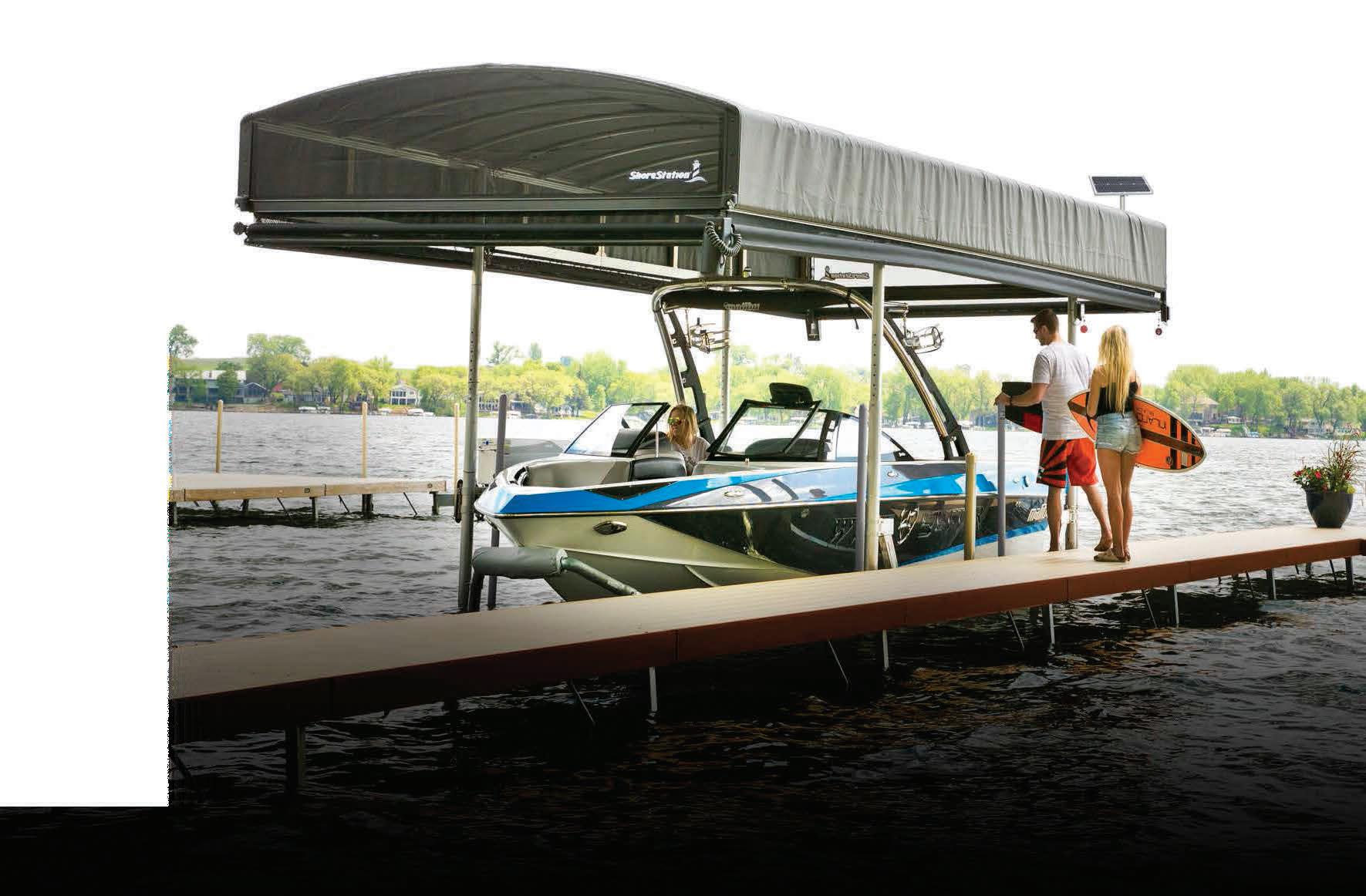






Equipped with exceptional weather resistant fabric and breathable SunTex 80 woven mesh ends for maximum protection and durability,

Made from the highest quality materials, our innovative hydraulic boat lift is one of the fastest and safest lifts on the market today. When you have a hydraulic lift, there’s no need to worry about wind and waves getting in your way. This lift will give you con dence to safely land and secure your boat in less-than-ideal conditions.
Never miss another moment on the water. Power your lift with clean, free solar power. Our speedy 20 watt charger features solar regulator drainage protection, saving your battery from permanent damage caused by overcharging.







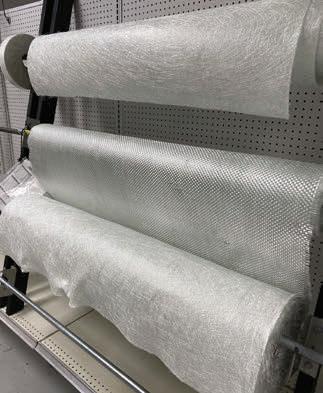

























By Will Schmidt
Sail!sh are known as the fastest !sh on the planet, but they o er more than blazing speed to those who chase them o Florida’s east coast, such as I did on a recent !shing excursion. Spectacular surface bites and astonishing acrobatics make these !sh a coveted catch for even the most experienced anglers. For !rst timers, it’s an adrenaline !led !ght that will stick with you long a er the !sh swims back into the cobalt blue Atlantic. is trip was special for a few reasons. First, we had rising country star Ben Gallaher (IG: @Ben_Gallaher) with us. Ben is an avid outdoorsman and bass !sherman, but he had never caught a saltwater !sh. I was also excited to !sh with some new friends, Capt. Geoge Gozdz of “Unfathomed” (IG: @captgeorgegozdz) and Chris Bishop, VP of marketing at Yo-Zuri (iG: @Yozuri_Lures).
A er just a short run o Port St Lucie, we set our spread, and I could sense any strikes would likely be dramatic. e water was crystal clear and glass at giving us a great view of any action. e !rst !sh in, came crashing into the spread chasing and slashing at a bait with its bill. Unfortunately, as aggressively as it came in, it turned and retreated without eating.
As we reset the spread anticipation grew to !nd Ben’s !rst saltwater adversary. Fortunately, another sail came in a smashed the right rigger. However, it ran right at us, and we were never able to get tight. Undaunted, we set up again. Soon all the baits were nervously darting on the surface. e le atline erupted as the sail slashed, splashed and devoured the bait. Ben was on, and this !sh leapt and twirled with all the acrobatics of a Cirque du Soleil show. ere was still another to eat and moments later we doubled up. Both !sh cooperated with plenty of arial antics and a er a good !ght we had both !sh to the boat. To say Ben was pumped to land his !rst bill!sh is an understatement. Amped up with adrenaline and ready for more he could only beam with an ear-to-ear grin and say “let’s go!”










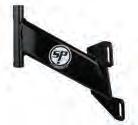

Fall !shing o of Port St Lucie o ers warm water and a hot bite without having to battle high winds and cold temperatures o en associated with winter sail!sh !shing in Florida.. Moreover, it’s not di&cult at all. We were simply bump trolling large, bridled thread!ns. Bridling helps the bait last longer and doesn’t allow for the hook to turn into the thread!n causing a missed strike. Our tackle was medium Penn Carnage rods with Authority reels lined with Yo-Zuri Super Braid topped with Yo-Zuri’s Disappearing Pink Fluorocarbon leader. ese setups gave us the sensitivity to feel the “eat” and the stealthiness to fool even the most cautious of !sh in these clear conditions. On your next trip don’t rush past these exciting sails, stop for some fun acrobatic action.
Will Schmidt is a seasoned tournament angler who has been writing about shing for more than two decades. Follow Will on Instagram @saltynstrong.



It’s no fsh tale when you run with a John Deere. You can get everything done faster and easier, so you get more time on the water. Plus, our special offers make them the catch of the day.




Anglers from around the world come to the U.S. Virgin Islands to !sh our incredible turquoise waters for trophy blue marlin, black!n tuna, wahoo and mahi-mahi. And with no passport required for U.S. citizens, it’s easy to plan your next !shing trip. Whether you want to set o on a crewed charter complete with a professional captain or prefer to simply cast a line from one of our scenic white-sand beaches, get ready to reel in the big one. Plus, many out!tters can customize your trip to include thrilling underwater activities like snorkeling.
O the island of St. Croix choose your own adventure, whether you’re looking to !sh o shore for mahi-mahi, wahoo, king!sh, tuna and blue marlin, or nearshore for tarpon, snapper, mackerel, rainbow runner and jacks. Seasoned crews who have been !shing the waters of USVI for decades will take you on customizable charters in search of catching your trophy !sh of a lifetime. Some out!tters o er complimentary !sh cleaning services, so all you have to do is throw your coveted catch on the grill or in the pan!
From St. John, troll for big game !sh—blue marlin, sail!sh, tuna, mahi-mahi and wahoo—on an o shore charter. Opt for a nearshore charter to catch bonito, barracuda, rainbow runner, snapper and
sharks. Or join an inshore bottom !shing trip to cruise the USVI’s deep-water reefs. Whether you’re an experienced angler or a novice needing some guidance, you’ll !nd an out!tter equipped with all the top-of-the-line !shing gear you’ll need for a successful day at sea.
About 20 miles north of St. omas is the North Drop, an area unparalleled for its big game !sh. Book a deep-sea !shing charter and sail over to this corner of the Caribbean that boasts more blue marlin bites per boat than any other place in the world. Half-day to 10-hour o shore bait !shing charters are ideal for adventurous anglers eager to experience the island’s famous North and South Drops. A mix of trolling and live baiting makes for mega catches, with yellow!n tuna, wahoo, mahi-mahi and blue marlin the most common catches of the day.

Surrounded by pristine blue waters, it’s no surprise that fresh seafood is a delicious part of nature’s bounty in USVI. You’ll !nd plenty of seafood-focused restaurants, from elegant !ne dining to laid-back waterfront eateries. Some out!tters even o er a stop at a seaside restaurant as part of their !shing excursions.


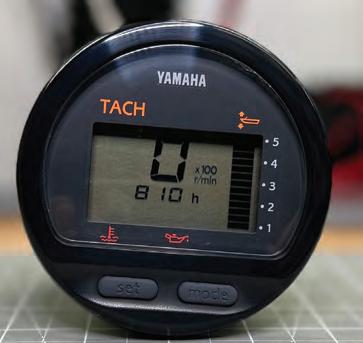




When the leaves start to turn and the water temps dip, bass anglers know what time it is—the fall feed. Bass are chasing bait like crazy, and it’s one of the best times of year to put big !sh in the boat. e trick is knowing what to throw as the season shi s. Here are !ve proven fall baits that will help you stay on the bite no matter what the lake throws at you.
Spinnerbait: Few baits scream “fall” like a spinnerbait. When the wind picks up and shad push shallow, it’s hard to beat a double willow blade ashing through the chop. e ash and thump imitate a school of eeing bait!sh, and hungry bass can’t resist. Target windy points, creek mouths, and shallow ats anywhere the bait’s getting pushed around.
Lipless Crankbait: is one’s all about covering water. Fall bass are constantly on the move, and a lipless crank lets you !nd ’em fast. Burn it over grass, rip it free when it hangs up, and hold on! at reaction bite is what fall !shing’s all about. Red or chrome patterns are money this time of year, especially when bass are chasing shad.
Jerkbait: Once the water clears and the temps drop into the 60s, it’s jerkbait season. Work it with a twitch-twitch-pause cadence, and you’ll mimic dying bait!sh to perfection. is lure shines around suspended bass that hang
o points or creek channels.


RJust be patient. Sometimes the bite comes right when you least expect it, on that long pause. Squarebill Crankbait & Swimbait: To round out your fall lineup, keep a squarebill and a swimbait on deck. A squarebill is your go-to for shallow cover stumps, rocks, laydowns, anywhere bass are ambushing bait in the backs of creeks. Meanwhile, a so or hard-bodied swimbait is ideal when you’re around big !sh feeding on larger forage. Slow-roll it through bait schools or along creek channels for some of the biggest bass of the year.
Fall is all about !nding the bait, and these !ve lures all mimic shad in their own way. Whether you’re slow-rolling a spinnerbait through wind-blown banks or ripping a lipless crank across a at, the !sh are feeding and it’s your job to get in on the action. Grab a few of these baits, follow the shad, and enjoy one of bass !shing’s most exciting seasons!
Tyler Woolcott is a professional tournament angler and guide. Check out his website at www.tylerwoolcott shing.com.

ed!sh are one of the most sought a er game !sh by inshore !shermen from Texas to the Carolinas. ey are great !ghters; they are great tasting; and they are perfect for sight !shing because they love super shallow water. Red!sh are part of the drum family and have four nostrils. is tells us that scent is their chosen sense while searching for food in dark and murky water.

e best red!sh lure that I have ever used is the 3-inch Berkeley Gulp! Shrimp. Berkeley Gulp! products are the smelliest baits that I have ever smelled and red!sh love them. ere are probably other stinky baits that work, but I haven’t found one that is comparable to Gulp! products. e best colors are anything with brown and gold glitter. Rootbeer and new penny are the best choices. e second best lure for catching red!sh is the gold or copper weedless spoon. ese are great search baits when you cannot see the red!sh. A slow retrieve with almost constant contact with the bottom is the way to !sh these lures. ese lures are exceptional for casting. ey cast a mile and let you cover a lot of water as you search for the schools of red!sh in the shallows.
e third best lure for red!sh are 3- and 4-inch paddletails rigged weedless. is is another great search bait for covering large areas of water. You will want to retrieve your paddletail in a similar way to your spoons. Make sure to bounce it o the bottom as you slowly retrieve it.
Contact Capt. Mike Smith, owner of Fish Your Ass O Charters, at (561) 339-2317, contact@ shyourasso .com or shyourasso .com.










“I never expected it to be so beautiful that it takes your breath away.”
— Kaya C., on Stauer Opals
In a quaint village, nestled between rolling hills, lived a young woman with a deep appreciation for gemstones. Her grandmother gifted her a delicate cross pendant adorned with opals. "e opals shimmered with a mesmerizing play of colors, reflecting hues of blues, greens, and fiery oranges. Her grandmother shared the legend of the opals, believed to bring hope, purity, and luck to those who wore them.
Using this story as inspiration, Stauer brings you the Opal Spirit Cross Pendant. With over 2 total carats of Kyocera lab-created opals set in .925 sterling silver encased in yellow gold, this pendant is a radiant celebration of beauty and craftsmanship. Each opal captivates with a kaleidoscopic dance of fiery oranges blending into oceanic blues, streaked with flashes of vibrant green that seem to come alive with every movement. "e shimmering opals are skillfully arranged to create an enchanting, otherworldly glow, embodying the spirit of hope and harmony. "is breathtaking combination of color and craftsmanship is available as a limited availability of only 930 pieces, making it a rare and treasured addition

to your jewelry collection. Plus, when you order today, you’ll receive the Opal Spirit Cross Pendant at an impossible price of just $59 normally $149!
Don’t miss your chance to own this exclusive tribute to timeless elegance and meaningful symbolism.
Jewelry Speci!cations:
• Pendant: 2 ½ ctw. Kyocera lab opals and DiamondAura® accents. Yellow gold-finished .925 sterling silver setting
• Chain: 18" gold-clad .925 sterling silver chain
Opal Spirit Cross Collection




ovember is almost a completely unique month of the year. We’ll start getting the !rst real cold fronts, and this will pile the bait on temp breaks. Structure on the bottom will certainly hold the grouper and snapper on the bottom, but pay attention to the recorder and the marks in the mid water column. ese marks can be a number of the targets we’re looking for. Black!n are a given during the month of November, but it’s “go time” for wahoo and yellow!n. e bait can stand colder water than the pelagics. is is one of their biggest defensive strategies, and why you should have a (realistic) jig ready that can !sh 75-150 feet deep around the bait balls because the surface water will likely be as much as a few degrees warmer that the surface water due to the cold wind blowing overhead. Keep live baits out on circle hooks and ourocarbon and try to get some lower in the water column. ese live baits are black!n bombs ready to go o , but I am always drawn to the bottom in search for the grouper and snapper. Some of these same live baits or frozen cigs and sardines on the correct jigs (hint, hint) are irresistible to the !sh I’m really looking for. I want the big grouper and snapper bite. When you !sh the correct baits using the correct presentation, you’re not asking them to eat it, you’re MAKING them eat it! BAM! is is also African pompano candy. e jig in the mid to lower part of the water column is deadly, but if there’s no bites !shing it deeper and deeper all the way to the bottom, bring it up to the surface and repeat the process.

A trolling motor will really help in this controlled dri , keeping the bow forward into the wind and/or current. is will keep the light line out back and the baits on or near the bottom slightly back depending on the current. is is the bottom line: bag the trolling crap, post up on stacks of bait with dedicated crew for the light line and/or jig and dedicated crew on the bottom to generate groceries in the cooler. is is my kind grocery shopping.
Learn the drill of how to !sh the entire water column nice and quiet with beautiful baits and tactics for results. Dress with proper !tting foul weather gear and take plenty of photos and videos you can enjoy for years to come.
Learn more from Tim Barefoot on his YouTube channel and at barefootcatsandtackle.com.

Spot Call: 352-447-1950









It was a warm summer afternoon and my wife and I were mingling with the best of them. The occasion was a 1920s-themed party, and everyone was dressed to the nines. Parked on the manse’s circular driveway was a beautiful classic convertible. It was here that I got the idea for our new 1920s Retrograde Watch.
Never ones to miss an opportunity, we carefully steadied our glasses of bubbly and climbed into the car’s long front seat. Among the many opulent features on display was a series of dashboard dials that accentuated the car’s lavish aura. One of those dials inspired our 1920s Retrograde Watch, a genuinely unique timepiece that marries timeless style with modern technology.

With its remarkable retrograde hour and minute indicators, sunburst guilloche face and precision movement, this design is truly one of a kind. What does retrograde mean? Instead of displaying the hands rotating on an axis like most watches, the hands sweep in a semicircle, then return to their starting point and begin all over again.
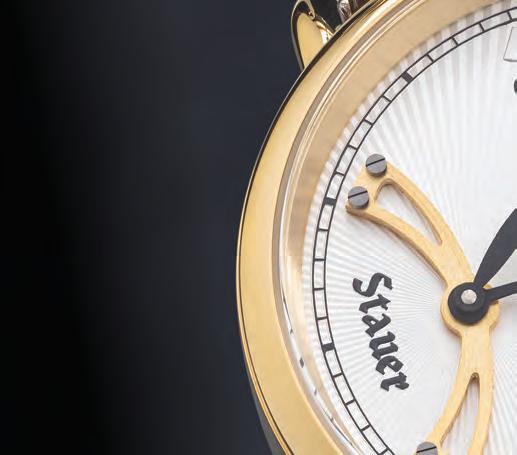
Retrograde watches by the big brands can set you back thousands; one recent offering from a big French fashion house is selling for more than $150,000! But because we’ve designed the 1920s Retrograde Watch in-house, we can offer it to you for just $99!
This watch is so wildly popular with our customers that we’re actually concerned about running out; we only have 937 729 left for this ad!
Join more than 1 MILLION smart people who love stauer watches

Watch Specifications:
• Precision movement
• Stainless steel case, caseback and crown
• Retrograde hour and minute indicators
• Water-resistant to 5 ATM




• Brown genuine leather band
• Fits wrists up to 8"
1920s Retrograde Watch
$399 $99* + S&P Save $300

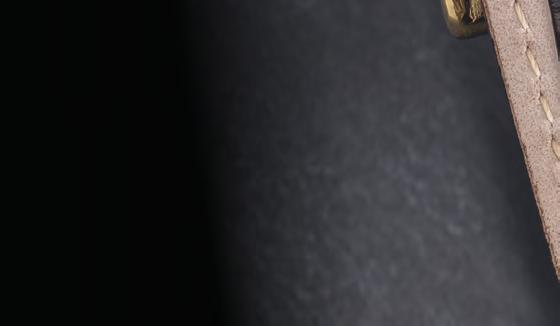
*Special price only for customers using the offer code.





“An elegant and exciting timepiece that every collector will love.”
— George Tomas, internationally renowned watch expert



“[A] unique and beautiful timepiece.”
— Carlos C., Los Banos, CA

